Kristine Hughes's Blog, page 160
February 2, 2011
Thos. Lawrence's Countess of Wilton Fetches £1,777,250
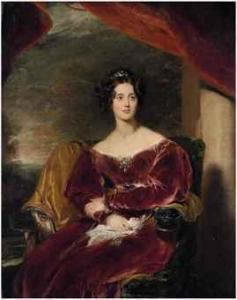
In light of the recent posts on this blog by Jo Manning and others regarding Sir Thomas Lawrence, we thought we'd let you know that Lawrence's portrait of Mary, Countess of Wilton (1801-1858), above, recently sold for £1,777,250 at Christie's in London.
Of special note is the fact that the Countess of Wilton was the daughter of Edward Stanley, 12th Earl of Derby, and his second wife, the celebrated Irish beauty and actress Elizabeth Farren (1759-1829), whom Lawrence painted early in his career and whose full length portrait won Lawrence name recognition and kudos when it was exhibited at the Royal Academy in 1790. You can read my prior post about the Farren portrait and the Regency Power and Brilliance Exhibition at the National Portrait Gallery in London here.
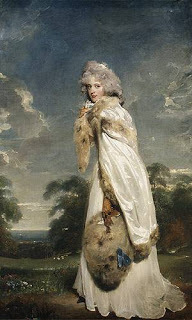 Elizabeth Farren, later Countess of Derby
Elizabeth Farren, later Countess of DerbyElizabeth (the daughter) married Thomas Egerton, 2nd Earl of Wilton, the second son of Robert Grosvenor, 1st Marquess of Westminster. The Countess of Wilton sat for her portrait in 1829, the year before Lawrence's death. On the Countess's death, we have the following:
"At Egerton-lodge. Melton Mowbray, the Countess of Wilton. The deceased lady had been for some time a little indisposed, but fatal results were not anticipated until shortly before her death. The late Countess was very highly esteemed at Melton, both in aristic circles and among the poor, to whom she was endeared by her active charity. The deceased lady was the youngest (and onlv survivor) of the three children of Edward, 12th Earl of Derby, by his second countess (Miss Eliza Farren, the celebrated actress). Her Ladyship was born on the 23rd of March, 1801, so that she was in the 58th year of her age. She was married to the Earl of Wilton on the 29th of November, 1821, and her ladyship leaves two sons and three daughters. The present Earl of Derby (the 14th Earl) stands in the relation of half-nephew to her ladyship, and (being born on the 29th of March, 1799) is two years older than his half-aunt." —Manchester Guardian.
For full notes and provenance on the Countess's portrait, visit the Christie's site here.
Published on February 02, 2011 01:41
February 1, 2011
Regency Reflections: The First Regency Crisis in 1788-89
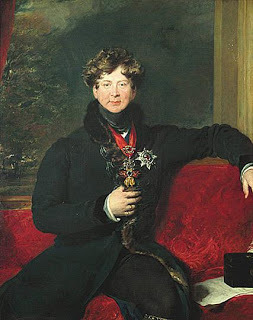 George, Princeof Wales as Prince Regent,
George, Princeof Wales as Prince Regent,by Sir Thomnas Lawrence, c. 1814This is the first of an occasional series of posts on the English Regency, which began 200 years ago. The Regency has innumerable definitions. In the arts, architecture, society, fashion, decor, and literature, we might date the Regency as being almost the same dates as the long 18th century, from the 1660 Restoration of the monarchy to the accession of Victoria in 1837. Others shorten it to the period between the American War (1776)and/or the French Revolution (1789) to the death of George IV in 1830 and/or William IV in 1837. The official Regency lasted nine years, from 1811-1820, when George III died and the Prince Regent became George IV.
The Regency was many years in the making. In the summer of 1788, King George III suffered what he called a bilious attack. After consultation with his wife, Queen Charlotte, and the royal physicians, the King and his entourage went to Cheltenham spa to take the waters. Though he had temporary relief, when he returned to Windsor in mid-August, things quickly deteriorated. Throughout the next few months, the King's condition worsened, combining physical and mental problems.
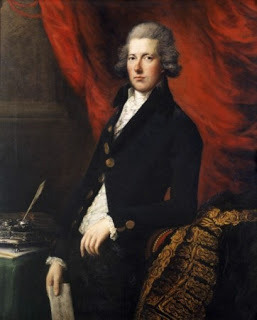 Prim Minister William PittThe political world of parliamentary leaders and ministers was alive with rumors and gossip based on long-held political rivalries and ambitions. Richard Brinsley Sheridan, in the absence of Charles James Fox (touring Italy), and other Whigs who enjoyed close friendships with George, Prince of Wales (who would be appointed as regent for his father if the regency bill was passed), were excited. The Whigs could almost taste their return to power. However, the Prime Minister William Pitt, a Tory to the core, saw the matter differently. He willed the King to recover. While stalling for time, a bill setting the conditions and restrictions of the regency was drawn up and debated.
Prim Minister William PittThe political world of parliamentary leaders and ministers was alive with rumors and gossip based on long-held political rivalries and ambitions. Richard Brinsley Sheridan, in the absence of Charles James Fox (touring Italy), and other Whigs who enjoyed close friendships with George, Prince of Wales (who would be appointed as regent for his father if the regency bill was passed), were excited. The Whigs could almost taste their return to power. However, the Prime Minister William Pitt, a Tory to the core, saw the matter differently. He willed the King to recover. While stalling for time, a bill setting the conditions and restrictions of the regency was drawn up and debated. 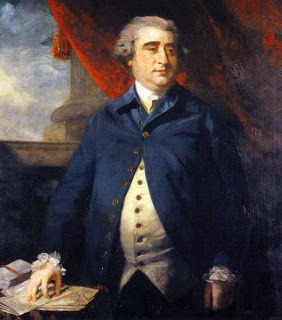 Charles James Fox, Whig leader
Charles James Fox, Whig leader The Prince of Wales, age 26, at first tried to stay publicly aloof from the debates. His life, which we have written about elsewhere and will no doubt write about again, was characterized by considerable conflict with his father. George III was strict with his sons, giving them an excellent education and expecting them to behave with propriety. But like the sons of so many English kings, (see The King's Speech for a more modern example), Prince George chose to go his own way with regard to lady friends, expensive architectural and collecting projects, and disobedience to his father's desires.
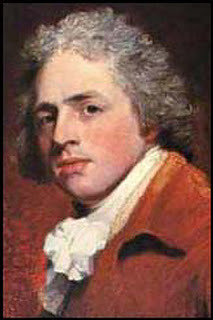 Richard Brinsley Sheridan, Whig leaderThe Prince considered himself a highly intelligent and principled connoisseur, a clever wit, and The First Gentleman of Europe. Others considered him self-indulgent, a spendthrift, and insensitive. But like so many sons of kings, he had no real job. He wanted to participate in the wars, and envied his brothers: Frederick's position in the Army and William's post in the Navy. In 1785, George married Maria Fitzherbert in a ceremony that defied the laws requiring the monarch' s approval, which couldn't have been given because she was a Roman Catholic.
Richard Brinsley Sheridan, Whig leaderThe Prince considered himself a highly intelligent and principled connoisseur, a clever wit, and The First Gentleman of Europe. Others considered him self-indulgent, a spendthrift, and insensitive. But like so many sons of kings, he had no real job. He wanted to participate in the wars, and envied his brothers: Frederick's position in the Army and William's post in the Navy. In 1785, George married Maria Fitzherbert in a ceremony that defied the laws requiring the monarch' s approval, which couldn't have been given because she was a Roman Catholic.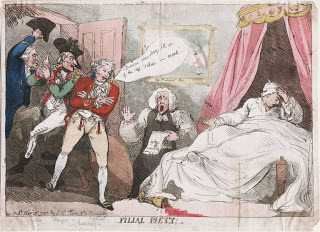 Thomas Rowlandson, Filial Piety (Lewis Walpole Library, Yale University) Charles James Fox, leader of the Whigs was traveling. His leadership was assumed by Richard Brinsley Sheridan, another Whig whose amorous adventures will fill a future blog. As the months passed without improvement in the King's health – or ultimate passage of the regency bill, the Prince of Wales began to be more obviously interested in his ultimate assumption of power. His interest did not escape the notice of the political satirists, such as Thomas Rowlandson. His Filial Piety, above.
Thomas Rowlandson, Filial Piety (Lewis Walpole Library, Yale University) Charles James Fox, leader of the Whigs was traveling. His leadership was assumed by Richard Brinsley Sheridan, another Whig whose amorous adventures will fill a future blog. As the months passed without improvement in the King's health – or ultimate passage of the regency bill, the Prince of Wales began to be more obviously interested in his ultimate assumption of power. His interest did not escape the notice of the political satirists, such as Thomas Rowlandson. His Filial Piety, above.
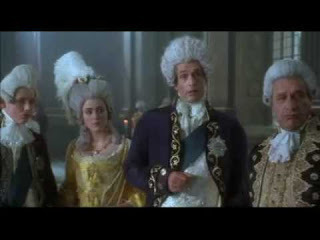 Rupert Everett in The Madness of King George, 3rd from leftBy February, the regency bill had passed the House of Commons and was about to be finally debated in the Lords when the King appeared to recover completely. He came back to London and the bill was taken off the Lords' agenda. A service of Thanksgiving for the King's Recovery was held at St. Paul's Cathedral in April of 1789.
Rupert Everett in The Madness of King George, 3rd from leftBy February, the regency bill had passed the House of Commons and was about to be finally debated in the Lords when the King appeared to recover completely. He came back to London and the bill was taken off the Lords' agenda. A service of Thanksgiving for the King's Recovery was held at St. Paul's Cathedral in April of 1789.These are the events chronicled in the play and film The Madness of King George (1994). Above is a still from the film showing the Prince of Wales as played by Rupert Everett waiting to hear the results of a parliamentary vote. The film is quite accurate in portraying the first regency crisis and the king's recovery.
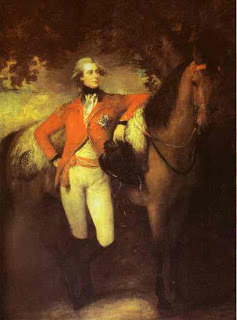 A flattering (slimming) portrait of the Prince, c. 1782
A flattering (slimming) portrait of the Prince, c. 1782We will investigate the next chapter in this drama soon.
Published on February 01, 2011 02:00
January 31, 2011
On The Shelf - Discovering New Authors - Part One

Occasionally, life treats us to rare gifts: a perfect summer's day, a hug when you're needing it most, an excellent pinot noir. If you're like me, perhaps one of life's greatest treats is the discovery of a new author. I'm always looking for them and recently I found a blog called My Porch, which I've added to the "Amusing Blogs" section found in the righthand sidebar of this blog. Written by a young man named Thomas who lives in Washington, D.C., it is a testament to his reading stamina, which beats my own with a very big stick. I enjoy his `voice' and his book reviews, but My Porch also boasts a long list of links to yet more book sites, many with a British bent. One can troll them for hours. Which one did until, finally, it dawned on me that Victoria and I might do a post on favorite authors, with healthy backlists, that could then be our gift to you. So here goes. One disclaimer before we continue - you won't find any romantic fiction here, not because we don't read it but because many of its authors are friends and once one begins naming friends one inevitably leaves someone out and then one finds oneself in the soup, so to speak. So. . . here are a few of my favorites, in no particular order, beginning with a category of books I term gentle reads. Victoria's picks in the same category will follow in Part Two. We sincerely hope you find a new author or two amongst them.
 Rebecca Shaw has written two cozy village series, the Barleybridge novels and the Turnham Malpas books. The Barleybridge series consists of three titles that deal with the lives and clients in a rural veterinary clinic. More prolific, the Turnham Malpas books, which number 15 titles, are set in a small village and opens with The New Rector. Here's the blurb: When Peter Harris arrives in Turnham Malpas as the new rector, he finds the village people welcoming but set in their ways. Yet despite his own weaknesses and the sadness of his childless wife, he comforts and advises his new parishioners, growing more and more involved with the rural way of life. Then the whole village is rocked by a spiteful trick that goes terribly wrong, and a gruesome murder that points to a killer in its midst. Now, more than ever, Peter's pastoral role is crucial - and yet he is wrestling with his own private hell that may still wreck his own life. Don't be turned off by the fact that the central character, at least in this title, is a member of the clergy. Shaw's books are rather like an adult version of the Miss Read books, more on which later. Peter's arrival in the village sets the stage for our introduction to a cast of quirky and mostly loveable characters who reappear in succeeding novels. Most storylines do not deal with the church, but do include forays into middle aged love, greed, scandals, char women, shop owners, the gentry, the downtrodden and a few chuckles. Here's the blurb for another title in the series, Village Matters: Times are changing in Turnham Malpas ...Brash Craddock Fitch up at the Big House seems determined to make his mark on the village - and the village is determined to put him in his place. Sir Ralph is having trouble adjusting to his more modest status and timid Muriel to her exalted one while a change of fortune surprises Jimmy Glover too. It's all Jimbo Charter-Plackett, fount of all gossip, can do to keep up. But these concerns are eclipsed by tragedy when Flick, Jimbo's daughter, is knocked down by the unpopular barman Alan. And before the shock of the accident has passed, a bitter dispute springs up that could affect the entire village ... Enough drama and 21st century situations happen in each title to keep them from being overtly quaint, while Shaw's characters and the dilemmas they find themselves in are firmly rooted in village life. You'll find her website here.
Rebecca Shaw has written two cozy village series, the Barleybridge novels and the Turnham Malpas books. The Barleybridge series consists of three titles that deal with the lives and clients in a rural veterinary clinic. More prolific, the Turnham Malpas books, which number 15 titles, are set in a small village and opens with The New Rector. Here's the blurb: When Peter Harris arrives in Turnham Malpas as the new rector, he finds the village people welcoming but set in their ways. Yet despite his own weaknesses and the sadness of his childless wife, he comforts and advises his new parishioners, growing more and more involved with the rural way of life. Then the whole village is rocked by a spiteful trick that goes terribly wrong, and a gruesome murder that points to a killer in its midst. Now, more than ever, Peter's pastoral role is crucial - and yet he is wrestling with his own private hell that may still wreck his own life. Don't be turned off by the fact that the central character, at least in this title, is a member of the clergy. Shaw's books are rather like an adult version of the Miss Read books, more on which later. Peter's arrival in the village sets the stage for our introduction to a cast of quirky and mostly loveable characters who reappear in succeeding novels. Most storylines do not deal with the church, but do include forays into middle aged love, greed, scandals, char women, shop owners, the gentry, the downtrodden and a few chuckles. Here's the blurb for another title in the series, Village Matters: Times are changing in Turnham Malpas ...Brash Craddock Fitch up at the Big House seems determined to make his mark on the village - and the village is determined to put him in his place. Sir Ralph is having trouble adjusting to his more modest status and timid Muriel to her exalted one while a change of fortune surprises Jimmy Glover too. It's all Jimbo Charter-Plackett, fount of all gossip, can do to keep up. But these concerns are eclipsed by tragedy when Flick, Jimbo's daughter, is knocked down by the unpopular barman Alan. And before the shock of the accident has passed, a bitter dispute springs up that could affect the entire village ... Enough drama and 21st century situations happen in each title to keep them from being overtly quaint, while Shaw's characters and the dilemmas they find themselves in are firmly rooted in village life. You'll find her website here.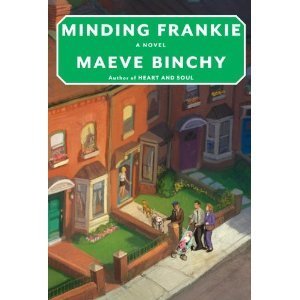 What can one say about Maeve Binchy except "read her?" Binchy is a master at characterization and story telling and each new title is, indeed, a long anticipated treat. Speaking of which, her latest, Minding Frankie, is due out on March 1. Here's the blurb: Maeve Binchy is back with a tale of joy, heartbreak and hope, about a motherless girl collectively raised by a close-knit Dublin community. When Noel learns that his terminally ill former flame is pregnant with his child, he agrees to take guardianship of the baby girl once she's born. But as a single father battling demons of his own, Noel can't do it alone. Fortunately, he has a competent, caring network of friends, family and neighbors: Lisa, his unlucky-in-love classmate, who moves in with him to help him care for little Frankie around the clock; his American cousin, Emily, always there with a pep talk; the newly retired Dr. Hat, with more time on his hands than he knows what to do with; Dr. Declan and Fiona and their baby son, Frankie's first friend; and many eager babysitters, including old friends Signora and Aidan and Frankie's doting grandparents, Josie and Charles. But not everyone is pleased with the unconventional arrangement, especially a nosy social worker, Moira, who is convinced that Frankie would be better off in a foster home. Now it's up to Noel to persuade her that everyone in town has something special to offer when it comes to minding Frankie. I've already pre-ordered this title on my Nook.
What can one say about Maeve Binchy except "read her?" Binchy is a master at characterization and story telling and each new title is, indeed, a long anticipated treat. Speaking of which, her latest, Minding Frankie, is due out on March 1. Here's the blurb: Maeve Binchy is back with a tale of joy, heartbreak and hope, about a motherless girl collectively raised by a close-knit Dublin community. When Noel learns that his terminally ill former flame is pregnant with his child, he agrees to take guardianship of the baby girl once she's born. But as a single father battling demons of his own, Noel can't do it alone. Fortunately, he has a competent, caring network of friends, family and neighbors: Lisa, his unlucky-in-love classmate, who moves in with him to help him care for little Frankie around the clock; his American cousin, Emily, always there with a pep talk; the newly retired Dr. Hat, with more time on his hands than he knows what to do with; Dr. Declan and Fiona and their baby son, Frankie's first friend; and many eager babysitters, including old friends Signora and Aidan and Frankie's doting grandparents, Josie and Charles. But not everyone is pleased with the unconventional arrangement, especially a nosy social worker, Moira, who is convinced that Frankie would be better off in a foster home. Now it's up to Noel to persuade her that everyone in town has something special to offer when it comes to minding Frankie. I've already pre-ordered this title on my Nook.  Author Marion Chesney is now busy churning out tiles in both the Agatha Raisin and Hamish MacBeth series. If you've never read them, by all means do. You'll find all the titles, and everything you need to know about them, on her website. Both are a series of cozy village mysteries, one set in the Cotswolds, the other in the Highlands of Scotland. Recurring characters and subplots, the standard cozy mystery fare, are both to be found. What isn't to be found, from one who has read them all, is anything new. After about the 15th book in each series, one gets to feel that they are simply reading the same book over and over again. And Hamish and Agatha's character flaws seriously begin to grind on one's nerves. Still, if you haven't read them before, you're in for a treat. What I really wish is that M.C. Beaton would give these books a rest and go back to what she does (did) best and that's writing Regency comedies as Marion Chesney. Yes, technically her books can be considered Regency romances, but I loved them for their plot lines and humour. And they were written in various series, so that you could settle in with a particular family and get to know all the members. These included the House for the Seasons, Travelling Matchmaker and Poor Relation series. You'll find a complete bibliography here. Marion, I know you're raking in the cash with Agatha and Hamish, but please consider returning to the 19th century.
Author Marion Chesney is now busy churning out tiles in both the Agatha Raisin and Hamish MacBeth series. If you've never read them, by all means do. You'll find all the titles, and everything you need to know about them, on her website. Both are a series of cozy village mysteries, one set in the Cotswolds, the other in the Highlands of Scotland. Recurring characters and subplots, the standard cozy mystery fare, are both to be found. What isn't to be found, from one who has read them all, is anything new. After about the 15th book in each series, one gets to feel that they are simply reading the same book over and over again. And Hamish and Agatha's character flaws seriously begin to grind on one's nerves. Still, if you haven't read them before, you're in for a treat. What I really wish is that M.C. Beaton would give these books a rest and go back to what she does (did) best and that's writing Regency comedies as Marion Chesney. Yes, technically her books can be considered Regency romances, but I loved them for their plot lines and humour. And they were written in various series, so that you could settle in with a particular family and get to know all the members. These included the House for the Seasons, Travelling Matchmaker and Poor Relation series. You'll find a complete bibliography here. Marion, I know you're raking in the cash with Agatha and Hamish, but please consider returning to the 19th century. 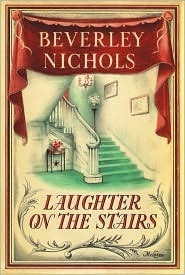 Beverley Nichols was the sort of man once euphamistically known as a "perennial bachelor." He was also a writer who managed to write between bouts of gardening, house renovations, visits from instrusive neighbors and caring for cats. Many of his books are about gardening and/or cats, neither subject known for its excitement value. There are no car chases, sexual adventures or titillation of any sort, but what these books do contain is Nichols's voice, which is at times fond, ironic, exasperated, plaintive or just plain pleased with itself. His first gardening book, Down the Garden Path, was illustrated — as were many of his books — by Rex Whistler. It was a bestseller running to 32 editions and has been in print almost continuously since 1932. It was also the first of his trilogy about Allways, his Tudor thatched cottage in Glatton, Cambridgeshire. A later trilogy written between 1951 and 1956 documents his travails renovating Merry Hall (Meadowstream), a Georgian manor house in Agates Lane, Ashtead, Surrey, where Nichols lived from 1946 to 1956. These books often feature his gifted but laconic gardener "Oldfield". Nichols's final trilogy is referred to as "The Sudbrook Trilogy" (1963–1969) and concerns his late 18th-century attached cottage at Ham, (near Richmond), Surrey. Sometimes Nichols waxes poetical about his endeavors - "To dig one's own spade into one's own earth! Has life anything better to offer than this?" At other times, he's just plain funny - "I was brought up surrounded by junk. It was no fault of my mother's, who had an exquisite, natural taste; it was merely a question of money. We had a large house, a quantity of hideous inherited furniture, and an abundance of positively frightening pictures. We had to put up with them." Here's a link to his website, where you'll find more excerpts from his books and you'll find blurbs and more about Nichols's titles here.
Beverley Nichols was the sort of man once euphamistically known as a "perennial bachelor." He was also a writer who managed to write between bouts of gardening, house renovations, visits from instrusive neighbors and caring for cats. Many of his books are about gardening and/or cats, neither subject known for its excitement value. There are no car chases, sexual adventures or titillation of any sort, but what these books do contain is Nichols's voice, which is at times fond, ironic, exasperated, plaintive or just plain pleased with itself. His first gardening book, Down the Garden Path, was illustrated — as were many of his books — by Rex Whistler. It was a bestseller running to 32 editions and has been in print almost continuously since 1932. It was also the first of his trilogy about Allways, his Tudor thatched cottage in Glatton, Cambridgeshire. A later trilogy written between 1951 and 1956 documents his travails renovating Merry Hall (Meadowstream), a Georgian manor house in Agates Lane, Ashtead, Surrey, where Nichols lived from 1946 to 1956. These books often feature his gifted but laconic gardener "Oldfield". Nichols's final trilogy is referred to as "The Sudbrook Trilogy" (1963–1969) and concerns his late 18th-century attached cottage at Ham, (near Richmond), Surrey. Sometimes Nichols waxes poetical about his endeavors - "To dig one's own spade into one's own earth! Has life anything better to offer than this?" At other times, he's just plain funny - "I was brought up surrounded by junk. It was no fault of my mother's, who had an exquisite, natural taste; it was merely a question of money. We had a large house, a quantity of hideous inherited furniture, and an abundance of positively frightening pictures. We had to put up with them." Here's a link to his website, where you'll find more excerpts from his books and you'll find blurbs and more about Nichols's titles here. 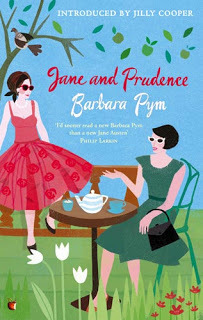 Barbara Pym is known for her novels that include village vignettes and snaps of social satire. In a book review, The Times said: "In Jane and Prudence, one character ironically compares herself to Austen's matchmaking heroine Emma Woodhouse – and turns out to be no better at finding a husband for her protégée than Emma was. This is Jane Cleveland, a vicar's wife, now in her forties, who hopes to see her best friend Prudence Bates – a sophisticated bachelor girl with a tendency to fall for unsuitable men – happily settled like herself. So she invites her to the village where her husband Nicholas is vicar, and introduces her to Fabian Driver, a handsome and eligible widower. But Prudence has an unlikely rival for Fabian's affections in mousy-looking Jessie Morrow, a lady's companion determined to escape her role as a spinster." For an article on Pym's writing, click here. You'll find the site for the U.S. Pym Society here. There's also a (hard to find) Barbara Pym Cookbook, featuring recipes mentioned throughout her books.
Barbara Pym is known for her novels that include village vignettes and snaps of social satire. In a book review, The Times said: "In Jane and Prudence, one character ironically compares herself to Austen's matchmaking heroine Emma Woodhouse – and turns out to be no better at finding a husband for her protégée than Emma was. This is Jane Cleveland, a vicar's wife, now in her forties, who hopes to see her best friend Prudence Bates – a sophisticated bachelor girl with a tendency to fall for unsuitable men – happily settled like herself. So she invites her to the village where her husband Nicholas is vicar, and introduces her to Fabian Driver, a handsome and eligible widower. But Prudence has an unlikely rival for Fabian's affections in mousy-looking Jessie Morrow, a lady's companion determined to escape her role as a spinster." For an article on Pym's writing, click here. You'll find the site for the U.S. Pym Society here. There's also a (hard to find) Barbara Pym Cookbook, featuring recipes mentioned throughout her books. 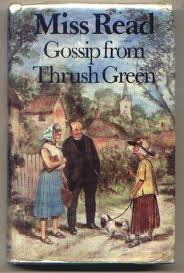 Born in 1913, Dora Jesse Saint began writing under the name Miss Read in 1955 and has charmed us ever since with her books set in both the fictional Fairacre and Thrush Green. The blurb for the first Thrush Green, titled the same, runs - "It's the May Day holiday, and a fair has come to the village of Thrush Green. The residents of Thrush Green all have their own views about the fair. For young Paul, just recovered from an illness, it is a joy to be allowed out to play at the fair; for Ruth, who returned to the soothing tranquillity of Thrush Green nursing a broken heart, the fair is a welcome distraction from her own problems. And for Dr Lovell, the fair brings an unexpected new patient. Then there is Mrs Curdle, the long-standing matriarch of the fair. For her, this year's visit to Thrush Green awakens mixed feelings, and a difficulty she doesn't want to face... Full of Miss Read's inimitable charm and humour, Thrush Green is a wonderful introduction to this bestselling series." While written in the 1950's, 60's and 70's, Miss Read's books read as though they hark back an even earlier time when life was simpler and time ticked by more slowly. The crisis encountered by the villagers in Thrush Green are more personal than global and are often solved by their being shared. Still, Miss Read uses insight to draw simple but richly felt characters with whom we instantly identify and for whom we care immensely. As we do for those characters who live in Fairacre ". . . a village of cottages, a church and the school - and at the heart of the school, its head mistress, Miss Read. Through her discerning eye, we meet the villagers of Fairacre and see their trials and tribulations, from the irascible school cleaner Mrs Pringle, to the young school children, with their scraped knees, hopeful faces and inevitable mischief. Miss Read takes us through the school year, beginning with the Christmas term, when the bitterly cold weather challenges the school's ancient heating system, right through to the hot summer day when school is over for another year. Full of Miss Read's unique, acerbic wit, and wry observations." These are books to savor and to read, and re-read, whenever the world we currently live in seems a bit too complicated for our liking. Miss Read retired from writing in 1996 and was made a Member of the Order of the British Empire in 1998. As far as I can make out, she is still alive. Hurrah! Why, I wonder, is there no Miss Read Society? You can find a complete bibliography of her books here.
Born in 1913, Dora Jesse Saint began writing under the name Miss Read in 1955 and has charmed us ever since with her books set in both the fictional Fairacre and Thrush Green. The blurb for the first Thrush Green, titled the same, runs - "It's the May Day holiday, and a fair has come to the village of Thrush Green. The residents of Thrush Green all have their own views about the fair. For young Paul, just recovered from an illness, it is a joy to be allowed out to play at the fair; for Ruth, who returned to the soothing tranquillity of Thrush Green nursing a broken heart, the fair is a welcome distraction from her own problems. And for Dr Lovell, the fair brings an unexpected new patient. Then there is Mrs Curdle, the long-standing matriarch of the fair. For her, this year's visit to Thrush Green awakens mixed feelings, and a difficulty she doesn't want to face... Full of Miss Read's inimitable charm and humour, Thrush Green is a wonderful introduction to this bestselling series." While written in the 1950's, 60's and 70's, Miss Read's books read as though they hark back an even earlier time when life was simpler and time ticked by more slowly. The crisis encountered by the villagers in Thrush Green are more personal than global and are often solved by their being shared. Still, Miss Read uses insight to draw simple but richly felt characters with whom we instantly identify and for whom we care immensely. As we do for those characters who live in Fairacre ". . . a village of cottages, a church and the school - and at the heart of the school, its head mistress, Miss Read. Through her discerning eye, we meet the villagers of Fairacre and see their trials and tribulations, from the irascible school cleaner Mrs Pringle, to the young school children, with their scraped knees, hopeful faces and inevitable mischief. Miss Read takes us through the school year, beginning with the Christmas term, when the bitterly cold weather challenges the school's ancient heating system, right through to the hot summer day when school is over for another year. Full of Miss Read's unique, acerbic wit, and wry observations." These are books to savor and to read, and re-read, whenever the world we currently live in seems a bit too complicated for our liking. Miss Read retired from writing in 1996 and was made a Member of the Order of the British Empire in 1998. As far as I can make out, she is still alive. Hurrah! Why, I wonder, is there no Miss Read Society? You can find a complete bibliography of her books here. There is an Angela Thirkell Society and you can find them here. In fact, our very own Victoria is a card carrying member and did a post on the Society that you'll find here. Barsetshire is a fictional county created by Anthony Trollope, which is featured in the series of novels known as the "Chronicles of Barsetshire" and where the county town and cathedral town is Barchester. Trollope's books have been made into various mini-series, namely The Way We Live Now and The Pallisers. I've just downloaded the first book in the Barsetshire series, The Warden, and will then move on to The Barsetshire Chronicles, also made into a mini-series. Barsetshire was also used as the setting for a series of 29 novels by Angela Thirkell, written from 1930 to 1961. Thirkell's stories blend social satire with romance. In Part Two, Victoria will tell you about Thirkell's books - and more.
Part Two Coming Soon!
Published on January 31, 2011 01:20
January 29, 2011
Regency Reflections: The Death of King George III
This post may appear a bit backwards, since before we begin our series on the regency of George, Prince of Wales, in a few days, we will mark its ending! The Prince Regent, upon the death of his father, King George III on January 29, 1820, became George IV.
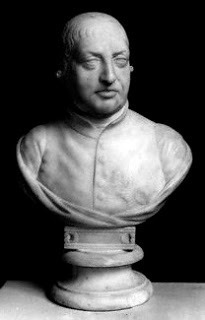 George III, 1809, NPGGeorge III had been incapacitated for at least nine years. He was blind and deaf; sometimes he knew what was happening around him, other times he was far away in a world of his own. It has been widely accepted that he (and perhaps other members of the Hanoverian royal family) suffered from porphyria, a disease that combined symptoms of both physical and mental illness. The King did not know Queen Charlotte had died in 1818.
George III, 1809, NPGGeorge III had been incapacitated for at least nine years. He was blind and deaf; sometimes he knew what was happening around him, other times he was far away in a world of his own. It has been widely accepted that he (and perhaps other members of the Hanoverian royal family) suffered from porphyria, a disease that combined symptoms of both physical and mental illness. The King did not know Queen Charlotte had died in 1818.
Since 1811, his eldest son, George, Prince of Wales, had ruled in his name.
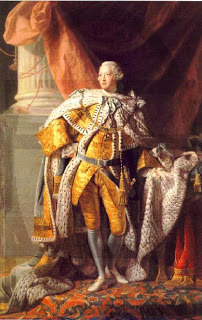 George III by Allan Ramsay, 1762
George III by Allan Ramsay, 1762
National Gallery, UKGeorge III (1738-1820) succeeded his grandfather, George II, in 1760. His father, Frederick, Prince of Wales, had died in 1751. Young and unmarried, George III soon took as a bride Princess Charlotte Sophia of Mecklenburg-Strelitz (1744-1818). They were wed in 1761 and had fifteen children.
Some of us Yanks know King George III as the man who "lost" the North American colonies." He was the person to whom the Declaration of Independence was addressed. And it is said that the loss of the colonies bothered George III all of his life.
But instead of the tyrant he was assumed to be in the colonies, George III wanted a quiet country life for his family. He was dutiful and loyal. Some called him the Farmer King, for he loved to work on the land. His sons were well educated and given some independence but his daughters, the six Princesses, were forced to conform to the dictates of their father and their mother, Queen Charlotte.
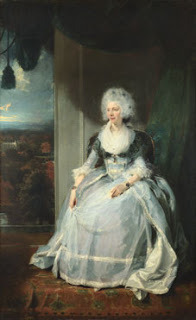 Queen Charlotte by Sir Thomas Lawrence
Queen Charlotte by Sir Thomas Lawrence
1789
Of King George III's fifteen children, twelve were still alive at his death. He had dozens of grandchildren, but almost all of them were illegitimate.
His first illness appeared with a vengenance in 1788 and 1789.
Many of us are familiar with the later years of George III's life from the play and film The Madness of King George, which was relatively accurate in portraying the crisis. And though he recovered, the illness recurred during the rest of his life. Eventually, in 1811, he gave up power to his son, the Prince Regent, and lived for the rest of his life at Windsor Castle. He was 81 at his death. Frederick, Duke of York, said to be his favorite son, was with him when he died.
The whole British nation mourned the passing of this king, and tens of thousands came to Windsor to observe the funeral procession. George III is buried in St George's Chapel within the castle walls.
In his excellent biography George III, (published in 1998 in Great Britain by Viking/Penquin and in the US by Basic Books), Christopher Hibbert quotes Mrs. Arbuthnot, close friend of the Duke of Wellington on the kings burial : "And thus has sunk into an honored grave the best man and the best king that ever adorned humanity….who for sixty long years had been a father to his people."
Below, St. George's Chapel, Windsor.
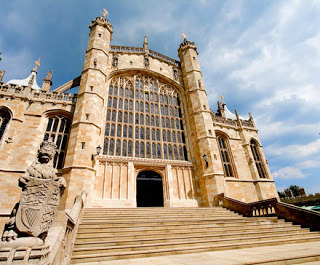

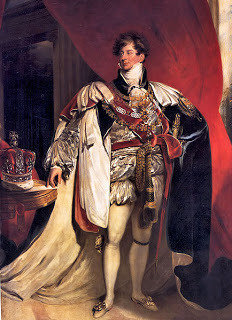 George IV, in his Coronation robes
George IV, in his Coronation robes

 George III, 1809, NPGGeorge III had been incapacitated for at least nine years. He was blind and deaf; sometimes he knew what was happening around him, other times he was far away in a world of his own. It has been widely accepted that he (and perhaps other members of the Hanoverian royal family) suffered from porphyria, a disease that combined symptoms of both physical and mental illness. The King did not know Queen Charlotte had died in 1818.
George III, 1809, NPGGeorge III had been incapacitated for at least nine years. He was blind and deaf; sometimes he knew what was happening around him, other times he was far away in a world of his own. It has been widely accepted that he (and perhaps other members of the Hanoverian royal family) suffered from porphyria, a disease that combined symptoms of both physical and mental illness. The King did not know Queen Charlotte had died in 1818. Since 1811, his eldest son, George, Prince of Wales, had ruled in his name.
 George III by Allan Ramsay, 1762
George III by Allan Ramsay, 1762National Gallery, UKGeorge III (1738-1820) succeeded his grandfather, George II, in 1760. His father, Frederick, Prince of Wales, had died in 1751. Young and unmarried, George III soon took as a bride Princess Charlotte Sophia of Mecklenburg-Strelitz (1744-1818). They were wed in 1761 and had fifteen children.
Some of us Yanks know King George III as the man who "lost" the North American colonies." He was the person to whom the Declaration of Independence was addressed. And it is said that the loss of the colonies bothered George III all of his life.
But instead of the tyrant he was assumed to be in the colonies, George III wanted a quiet country life for his family. He was dutiful and loyal. Some called him the Farmer King, for he loved to work on the land. His sons were well educated and given some independence but his daughters, the six Princesses, were forced to conform to the dictates of their father and their mother, Queen Charlotte.
 Queen Charlotte by Sir Thomas Lawrence
Queen Charlotte by Sir Thomas Lawrence1789
Of King George III's fifteen children, twelve were still alive at his death. He had dozens of grandchildren, but almost all of them were illegitimate.
His first illness appeared with a vengenance in 1788 and 1789.
Many of us are familiar with the later years of George III's life from the play and film The Madness of King George, which was relatively accurate in portraying the crisis. And though he recovered, the illness recurred during the rest of his life. Eventually, in 1811, he gave up power to his son, the Prince Regent, and lived for the rest of his life at Windsor Castle. He was 81 at his death. Frederick, Duke of York, said to be his favorite son, was with him when he died.
The whole British nation mourned the passing of this king, and tens of thousands came to Windsor to observe the funeral procession. George III is buried in St George's Chapel within the castle walls.
In his excellent biography George III, (published in 1998 in Great Britain by Viking/Penquin and in the US by Basic Books), Christopher Hibbert quotes Mrs. Arbuthnot, close friend of the Duke of Wellington on the kings burial : "And thus has sunk into an honored grave the best man and the best king that ever adorned humanity….who for sixty long years had been a father to his people."
Below, St. George's Chapel, Windsor.


 George IV, in his Coronation robes
George IV, in his Coronation robes
Published on January 29, 2011 02:00
January 28, 2011
The Wellington Connection - The Tower of London
It was a cold, wet, foggy day when we visited the Tower of London - a day chock full of atmosphere and history.
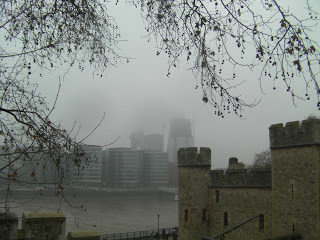
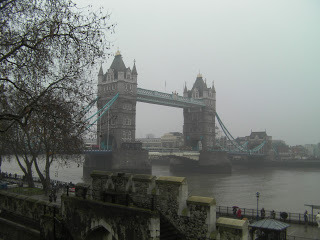
Of course, the Tower is a must see for any first time visitor to London and that's why it was on our agenda, so that Greg could take it all in. Not surprisingly, the Duke of Wellington made an appearance here, as well, having served as Constable of the Tower for 26 years. As I said to Greg, "You've got to give it to Artie, he had his fingers in so many pies."
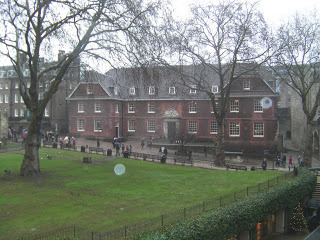
The Waterloo Barracks
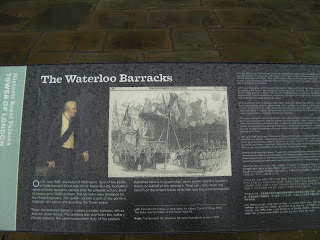
The Waterloo Barracks at the Tower were built while Wellington was Constable and named after his famous victory over Napoleon. The building replaced the Grand Storehouse which was destroyed by fire in 1841 and the foundation stone, laid by the Duke of Wellington in 1845, can be seen at the north-east end of the building. The fire, which had taken place on October 30, 1841, at 10:30 p.m. was caused by an overheated flue in the Bowyer Tower. Thirty minutes later, the Bowyer Tower was almost completely destroyed, and the fire had spread to the armories and storehouse to the east of the Chapel of St. Peter ad Vincula. By midnight the armories were burning so furiously that the heat caused the lead pipes to melt on the walls of the Great Tower. The Brick Tower then caught fire, and flames threaten to burn Martin Tower where the Crown Jewels of England were kept. The Keeper of the Jewel House only had the key to the outer room (the Lord Chamberlain had the other keys). Water was sprayed on the walls of Martin Tower as firemen tried to keep the walls cooled down until the Crown Jewels could be removed. One firemen was killed when he was hit by a piece of falling stone. Using crowbars, policemen bent back the bars from in front of the Crown Jewels. A brave policeman handed out the Crown Jewels piece by piece. He did not leave, even though his uniform was charred from the heat, until everything, except a silver font which would not fit through the bars, had been saved. The fire was finally under control at 3:15 a.m., but the two armories, storehouse, Bowyer Tower, and the Brick Tower were destroyed, and both the Chapel of St. Peter ad Vincula and the Great Tower (White Tower) were badly damaged. The Duke of Wellington was Tower Constable at the time of the fire (he was appointed in 1826), and with the help of Prince Albert, Wellington spearheaded a campaign to get government funds to restore and rebuild the Tower of London. This massive project lasted throughout the rest of the 19th century.
At the time Wellington became Constable in 1826, the post of Yeoman Warder could be bought for 250 guineas, or even inherited within families. The Duke brought these practices to an end, making appointments based on distinguished military service. He also made improvements to the Tower itself. By 1841, in the words of the Surgeon-Major, the moat was 'impregnated with putrid animal and excrementitious matter…and emitting a most obnoxious smell.' Several men from the garrison died and 80 were in hospital due to the poor water supply. Local cholera outbreaks were blamed on the moat. The duke drained it and created the dry ditch, or fosse, that visitors see today.
 Lion's skull found in drained Tower moat The menagerie at the Tower was once filled with exotic animals and was a popular tourist attraction. It was established by King John, who reigned in England from 1199-1216, and is known to have held lions, elephants, leopards, camels, ostrich and bears. The menagerie was finally closed in 1835, on the orders of the Duke of Wellington, and the remaining animals were moved to the Zoological Society's Gardens in Regent's Park, now known as London Zoo.
Lion's skull found in drained Tower moat The menagerie at the Tower was once filled with exotic animals and was a popular tourist attraction. It was established by King John, who reigned in England from 1199-1216, and is known to have held lions, elephants, leopards, camels, ostrich and bears. The menagerie was finally closed in 1835, on the orders of the Duke of Wellington, and the remaining animals were moved to the Zoological Society's Gardens in Regent's Park, now known as London Zoo.
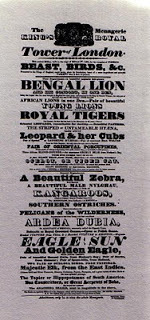 A list of animals in the menagerie during the reign of George IV
A list of animals in the menagerie during the reign of George IV
To learn more about the history of the Tower menagerie, click on the book cover.

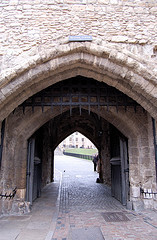
Finally, the Duke made some improvements to the portcullis at the Bloody Tower, above. Look closely and you'll see spiked, black iron bars on either side of the doorway at about knee height. The Duke ordered these to be installed so that the guards would no longer be able to lounge against the wall and smoke whilst on duty - ha!
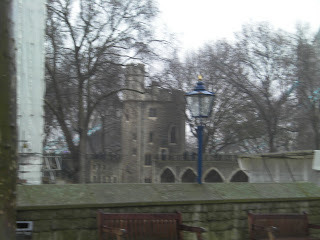



Of course, the Tower is a must see for any first time visitor to London and that's why it was on our agenda, so that Greg could take it all in. Not surprisingly, the Duke of Wellington made an appearance here, as well, having served as Constable of the Tower for 26 years. As I said to Greg, "You've got to give it to Artie, he had his fingers in so many pies."

The Waterloo Barracks

The Waterloo Barracks at the Tower were built while Wellington was Constable and named after his famous victory over Napoleon. The building replaced the Grand Storehouse which was destroyed by fire in 1841 and the foundation stone, laid by the Duke of Wellington in 1845, can be seen at the north-east end of the building. The fire, which had taken place on October 30, 1841, at 10:30 p.m. was caused by an overheated flue in the Bowyer Tower. Thirty minutes later, the Bowyer Tower was almost completely destroyed, and the fire had spread to the armories and storehouse to the east of the Chapel of St. Peter ad Vincula. By midnight the armories were burning so furiously that the heat caused the lead pipes to melt on the walls of the Great Tower. The Brick Tower then caught fire, and flames threaten to burn Martin Tower where the Crown Jewels of England were kept. The Keeper of the Jewel House only had the key to the outer room (the Lord Chamberlain had the other keys). Water was sprayed on the walls of Martin Tower as firemen tried to keep the walls cooled down until the Crown Jewels could be removed. One firemen was killed when he was hit by a piece of falling stone. Using crowbars, policemen bent back the bars from in front of the Crown Jewels. A brave policeman handed out the Crown Jewels piece by piece. He did not leave, even though his uniform was charred from the heat, until everything, except a silver font which would not fit through the bars, had been saved. The fire was finally under control at 3:15 a.m., but the two armories, storehouse, Bowyer Tower, and the Brick Tower were destroyed, and both the Chapel of St. Peter ad Vincula and the Great Tower (White Tower) were badly damaged. The Duke of Wellington was Tower Constable at the time of the fire (he was appointed in 1826), and with the help of Prince Albert, Wellington spearheaded a campaign to get government funds to restore and rebuild the Tower of London. This massive project lasted throughout the rest of the 19th century.
At the time Wellington became Constable in 1826, the post of Yeoman Warder could be bought for 250 guineas, or even inherited within families. The Duke brought these practices to an end, making appointments based on distinguished military service. He also made improvements to the Tower itself. By 1841, in the words of the Surgeon-Major, the moat was 'impregnated with putrid animal and excrementitious matter…and emitting a most obnoxious smell.' Several men from the garrison died and 80 were in hospital due to the poor water supply. Local cholera outbreaks were blamed on the moat. The duke drained it and created the dry ditch, or fosse, that visitors see today.
 Lion's skull found in drained Tower moat The menagerie at the Tower was once filled with exotic animals and was a popular tourist attraction. It was established by King John, who reigned in England from 1199-1216, and is known to have held lions, elephants, leopards, camels, ostrich and bears. The menagerie was finally closed in 1835, on the orders of the Duke of Wellington, and the remaining animals were moved to the Zoological Society's Gardens in Regent's Park, now known as London Zoo.
Lion's skull found in drained Tower moat The menagerie at the Tower was once filled with exotic animals and was a popular tourist attraction. It was established by King John, who reigned in England from 1199-1216, and is known to have held lions, elephants, leopards, camels, ostrich and bears. The menagerie was finally closed in 1835, on the orders of the Duke of Wellington, and the remaining animals were moved to the Zoological Society's Gardens in Regent's Park, now known as London Zoo. A list of animals in the menagerie during the reign of George IV
A list of animals in the menagerie during the reign of George IVTo learn more about the history of the Tower menagerie, click on the book cover.


Finally, the Duke made some improvements to the portcullis at the Bloody Tower, above. Look closely and you'll see spiked, black iron bars on either side of the doorway at about knee height. The Duke ordered these to be installed so that the guards would no longer be able to lounge against the wall and smoke whilst on duty - ha!

Published on January 28, 2011 01:03
January 27, 2011
The Story Behind True Soldier Gentlemen by the Author, Guest Blogger Dr. Adrian Goldsworthy
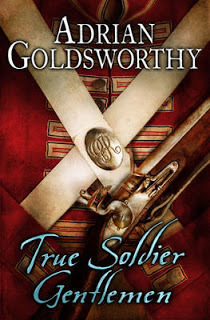
Writing historical novels is a long cherished dream. I love history, and if the Romans have always had a special place in my heart, I find plenty of other periods almost as fascinating. For all that widespread interest, the Napoleonic and Regency has long been a particular obsession.
It probably began as a boy, watching the film Waterloo on television, and then when Bernard Cornwell's Sharpe's Eagle - the first of the series - was released. I devoured this and all its successors, along with C.S. Forester and his many imitators, as well as Patrick O'Brian who gave such a unique take on the genre. The fiction quickly led me to the real history of those times, and especially the wealth of letters and memoirs left by the men and women of those years of Regency in England and Revolution and Empire in France. So many of the real events and characters were stranger and more dramatic than anything a novelist would dare to invent, and there is so much human detail of everyday life during peacetime and on campaign. It was such a remarkable age, gaudy and inspiring, filled with larger the life characters and epic moments.
There is a lot of naval fiction out there, and new series seem to begin almost every year. Oddly, in spite - or perhaps because of - the success of Sharpe in books and on TV, there are very few adventure stories about Wellington's men. Allan Mallinson's series about the Light Dragoon Matthew Hervey begins in 1814, and apart from a few flashbacks, deals mainly with the world after Waterloo. Cornwell has on the whole moved on to other periods.
 Dr. Adrian Goldsworthy I wanted to go back to the world of the redcoats, and True Soldier Gentlemen is the result. The big events and the major figures are all real. My main characters are invented, but I wanted them to act and speak in ways in keeping with the period, so that they could have existed. For most people, Regency England is inseparably linked with Austen's novels and their frequent dramatisation on the large and small screens. The aim was to capture something of their feel. (Reading them at school had anyway always made me wonder what her various military and naval characters got up to as the war with France raged off-stage. Austen can seem desperately slow-paced to a boy, and I did not really take a delight in her work until I returned to the books as an adult).
Dr. Adrian Goldsworthy I wanted to go back to the world of the redcoats, and True Soldier Gentlemen is the result. The big events and the major figures are all real. My main characters are invented, but I wanted them to act and speak in ways in keeping with the period, so that they could have existed. For most people, Regency England is inseparably linked with Austen's novels and their frequent dramatisation on the large and small screens. The aim was to capture something of their feel. (Reading them at school had anyway always made me wonder what her various military and naval characters got up to as the war with France raged off-stage. Austen can seem desperately slow-paced to a boy, and I did not really take a delight in her work until I returned to the books as an adult).Army officers were in many ways the male counterparts of Austen's heroines. The majority of army officers were not rich or well connected, and their claim to genteel status resting on precarious grounds. Few could afford to purchase promotion, and they had little control over postings. A man's career might stagnate in Britain, or be ended abruptly by disease if the battalion was sent to the West Indies, which consumed units at quite staggering rates. War service brought more opportunities for advancement at the risk of death and dreadful injury – and indeed increased chance of succumbing to disease. All the time a man's conduct was regulated by strict rules. No gentleman could strike another, unless in a formal duel. (Richard Sharpe is a wonderful creation, but no one could have got away with behaving like that. Knowing that has never made me take any less delight in the stories, and I wish I could write half as well as Cornwell).
Like wider Regency Society, most army officers drank heavily and many gambled freely. There were plenty of opportunities to disgrace themselves and be forced to resign. There were also constant frustrations as better connected or wealthier men advanced their careers far faster than was possible for most. Officers who chose to marry, or who had to assist their parents and siblings struggled even harder to cope, but many somehow managed to do this.
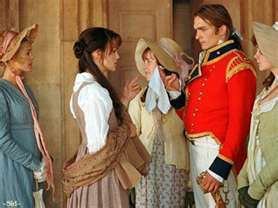 I could not resist including Wickham in the story. At the end of Pride and Prejudice Austen has Darcy buy him a commission in the regular army and help his future career, and this gave me the opportunity. Using the excuse that she is vague about the date, I decided to accept the view that 'the Peace' she mentions was the short-lived Peace of Amiens. Wickham is not really interesting enough to be the centre of the stories in the style of George MacDonald Fraser's marvellous Flashman novels. Instead he is there, charming and untrustworthy, doing his best to seduce pretty women and avoid paying his debts, while other characters do most of the work. Yet his connection to Darcy will allow him to rise, as long as his misbehaviour does not become too blatant. He also helps to add to the humour of the story. Over-serious adventure stories tend to be tiresome. Apart from that, all the soldiers I have known or read about always laugh a lot, and the aim was to capture something of that spirit.
I could not resist including Wickham in the story. At the end of Pride and Prejudice Austen has Darcy buy him a commission in the regular army and help his future career, and this gave me the opportunity. Using the excuse that she is vague about the date, I decided to accept the view that 'the Peace' she mentions was the short-lived Peace of Amiens. Wickham is not really interesting enough to be the centre of the stories in the style of George MacDonald Fraser's marvellous Flashman novels. Instead he is there, charming and untrustworthy, doing his best to seduce pretty women and avoid paying his debts, while other characters do most of the work. Yet his connection to Darcy will allow him to rise, as long as his misbehaviour does not become too blatant. He also helps to add to the humour of the story. Over-serious adventure stories tend to be tiresome. Apart from that, all the soldiers I have known or read about always laugh a lot, and the aim was to capture something of that spirit. The real heroes of the stories will be a group of young men without influence. One of them, Williams, serves in my fictional 106th Regiment as a Gentleman Volunteer. This was a peculiar status, where a man lived with the officers, but served in the ranks, wearing the uniform and doing the duty of an ordinary soldier. They hoped to be commissioned when disease or battle created vacancies. At the height of the Peninsula War, about one in twenty of Wellington's officers were commissioned in this way. This is the sort of strange status that is fun to explore, and not really that well known about these days.
True Soldier Gentlemen has always been intended as the start of a series, and I hope readers will have patience with a book that takes a while to introduce a large cast of characters. The idea is to take them through the years up to Waterloo. Although I have plenty of ideas, and a fair notion of where they will go, I am not yet sure what will happen to them all. I have also tried to give something of the sedate feel of Austen's world, so that the peace and formality of England contrasts all the more with the extreme savagery of the Peninsula War.
It is an adventure, hopefully an enjoyable yarn, and has no pretensions whatsoever to being literature. Ultimately, it is the sort of novel I enjoy reading.
Today is the official release date for True Soldier Gentlemen in the UK and at present there no US edition planned. You can order here through Amazon UK . The sequel, Beat the Drums Slowly, is due out in August of this year.
You can visit the author's website here .
Published on January 27, 2011 01:18
Let's Play Telephone Contest Winner

We're pleased to announced that the winner of the contest is Louisa Cornell, who submitted the following (most amusing) telephone conversation:
Hello? Maria, dear, I told you never to call me here. I know dearest. I'll try my best to be home for dinner, but affairs of state and all that, you know. Wait a moment, dear, I'm getting another call. ---- Mary! How did you get this number? I mean, aren't you in rehearsals, dear? No, of course not. Of course there's not another woman. Who can compare with my lovely Perdita? Tonight? Oh… Uhm … I have another call. Let me call you back. ---- Maria, I really need to get to a meeting with – Who? Oh, no of course not, Grace. Maria is my … housekeeper in Brighton. Grace, how did you get this number? What? Tonight? Well, I don't exactly- I have another call, Grace, dear. You'll hold? Wonderful. ---- Hello? Who is this? Of course this is George! Who else would it be? Oh! Lady Jersey, what a surprise. What? Caroline who? Caroline of Brunswick. I thought you said she looks like a horse and smells like one as well. …. You've changed your mind? I see. Well, I am certain the privy council will agree with you. This afternoon? I'm not exactly sure what I'll be doing. Getting another call. Let me call you back. --- Brummell! You unmitigated ass! I should have known. Who else have you given this number to, you overdressed . . . All of them? Oh God!
Louisa - Email us off line with your snail mail address and we'll get your prizes in the post to you!
Published on January 27, 2011 01:16
January 26, 2011
On The Shelf - NOOK Color Kicks Off Our Author Recommendations

I was once out shopping with a friend when I spotted a killer pair of Ralph Lauren sunglasses. When I told her that I really liked them, but that at the same time I already had many pair of sunglasses and didn't need yet another, she sniffed and pronounced, "My dear, it's not a matter of need. It's a matter of want. Buy them."
While I've lived by her words many times over the years, I must admit that I dragged my feet when e-readers first came out. Why buy something that's the size of a book, that you can hold in your hand and read like a book when you could just read a book? And why pay for a book, when you could get it free at the local public library?
Then, Barnes and Noble came out with the NOOK color, an Android tablet fronted by a 7-inch color touchscreen with 8GB of internal memory and a microSD card slot for cards up to 32GB. It functions as both an e-reader and a web browser. All for $249.00 - much cheaper than an iPad or notebook. Curious, I went on the Barnes and Noble website in order to invesigate and found that it offered lots of capability. The NOOK sounded like a good deal. It sounded like something I didn't absolutely need, but certainly wanted. And what do you know - Greg took it upon himself to surprise me with one for Xmas. Here are a look at the features:
1. You can download books into the NOOK in seconds. Using the NOOK to read a book is so easy, you don't even need the instructions. Just tap on a book cover and it opens. A swipe at the corner of the screen turns the page, just like a "real" book. When you're done reading, turn the NOOK off and when you turn it on again, it remembers what page you were on and opens to it. Downloaded books are stored on your "shelves," which you can customize. My NOOK shelves are named tbr and done. Yes, tbr, as in to be read. No more tottering piles of tomes by the side of my bed. Still a pile, true, since every book ever written is not offered as a NOOK download as yet and since some books, especially non-fiction titles, were simply not meant to be read in any other format than that of a good, old fashioned hard-bound book. I plan on using my NOOK for fiction only. But that may change.


2. The NOOK has built-in wifi that allows you to browse the web. The only things that's a tad difficult to do is to click on individual results, as the screen is pretty small. There's a plus (+) and minus (-) icon that comes up fairly intuitively in the lower righthand corner of the screen that allows you to magnify the screen when you're performing a function that requires data entry. And you can call it up any other time you need it. Having web capability in an e-reader is a plus - you can shop for more book titles, check your email, Google to your hearts' content, etc. It's handy, especially when on the road.
3. NOOK's built-in MP3 player lets you listen to audio books. Boy, did I get excited over this one! I cannot wait to do this - I can "read" and do needlework at the same time - oh, joy! But now we open another can of worms - can I download any audiobook? And a cursory browse on the web shows that I may be able to download e-books, including audio books, from my public library. Technology begets further technology and now I'll have to spend time investigating these options, but it's nice to know they're available.

4. You can subscribe to magazines and each issue is automatically delivered to your NOOK each month. Or you can buy single issues. Have yet to try this . . . . as with non-fiction books, I think reading magazines in this format may take some getting used to.
5. The NOOK's LendMe function means that books can be shared once with a friend at no cost, for up to 14 days. From the B and N webiste: "NOOKcolor makes it easy to borrow books from friends for up to 14 days. Just pull up your list of contacts, then browse a friend's NOOKcolor library to choose the book you want to borrow. Within seconds, NOOKcolor will send an email to your friend with a request to borrow that book. Once they give the ok, the book will appear right on your NOOKcolor in seconds ready for you to download and enjoy." This sounds pretty exciting, until you realize that the number of lendable books is fairly limited. While I have current titles on my tbr shelf (Ruth Rendell's Portobello), and have even pre-ordered titles, (such as Maeve Binchey's Minding Frankie, due out on March 1), only two of the titles on my shelf have a LendMe icon - The Black Moth by Georgette Heyer (my cost - .99) and Barchester Towers by Trollope (my cost - $1.99). LendMe might not be as fabulous as I first thought. Even Austen's Pride and Prejudice isn't lendable.
6. The NOOK is supposed to last 8 hours on a charge. The more you use the web, the more power you use up. Even when used just for reading, I find a single charge lasts around 6 hours.
As an e-reader the NOOK color is fabulous. How did I get by without it? True, I'm now spending money on books that I would have gotten free from the library, but then again, I'm not 187th on the list for new releases. Even so, I'm sure I'll still be borrowing books from the library, the old fashioned way, but the NOOK is a useful tool and a wonderful addition to my bookshelves.
Understandably, the appearance of my NOOK has prompted much book browsing for me of late, in addition to reflections about favorite authors whose work I haven't read in a while. And Victoria has a Kindle, which she uses often. She and I met at a Barnes and Noble store here in Florida recently and spent some time discussing favorite authors, old and new, and we've decided to bring you our author recommendations in forthcoming On The Shelf posts, beginning on January 31st. It is our fondest hope that you'll find a few new favorites amongst them, too.
Published on January 26, 2011 01:23
January 25, 2011
The Royal Wedding on the Telly
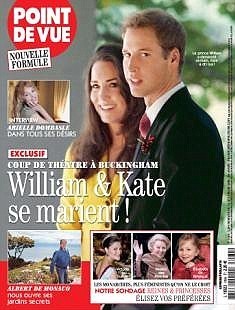
With just 90-something days to go till the Wedding of the Year/Decade, you can bet that news outlets and television stations on both sides of the pond, and elsewhere, are plotting their strategies and schedules for the weeks and days leading up to the big event at 11 a.m. on April 29th. So far, TLC is the only channel that's given out any information on their royal line up - during the five days leading up to royal wedding, TLC said on Wednesday that it will air specials featuring archived and other footage, interviews and a round-table discussion with experts on royalty. The U.K.-themed week, in partnership with ITV Studios, also will include a show focusing on both British and American hoarders and "extreme" collectors of royal memorabilia. One hopes they'll focus on the lady featured in our left sidebar and not on, er, one.
TLC also plans live coverage of the wedding, with a condensed version of the event set to air April 30-May 1. But you won't have to wait till April - beginning next month, TLC will show "The Queen," a new two-hour special that explores romance, weddings and divorce among members of Queen Elizabeth II's family. The special will air Feb. 13 (9 p.m. EST). The program will be preceded by repeats of two specials about William and his fiancee: "William and Kate: A Royal Love Story" (7 p.m. EST) and "William, Kate and Royal Weddings" (8 p.m. EST).
For TLC, home of "Four Weddings," "Say Yes to the Dress" and other wedding-themed shows, the week long coverage is intended to enhance viewers' "overall royal experience" of the Westminster Abbey ceremony, said programming executive Nancy Daniels.
"This is without question the most widely anticipated wedding in a generation," Paul Buccieri, ITV Studios America president and CEO, said in a statement, promising American viewers "intimate access to this landmark event."
Right . . . . . Just you, me and a couple of million others . . . . . Reports are that Rupert Murdoch's British Sky Broadcasting Group is negotiating with royal officials to show the nuptials on television, and the talks, which involve the BBC, also are said to include a plan to possibly shoot the ceremony in 3-D and broadcast it to cinemas throughout the world. Which will delight the folks at Royal Caribbean Cruises, who plan to broadcast the wedding live across all 40 ships in their fleet on 29th April.
Stay tuned . . . . . .
Published on January 25, 2011 01:07
Kristine Hughes's Blog
- Kristine Hughes's profile
- 6 followers
Kristine Hughes isn't a Goodreads Author
(yet),
but they
do have a blog,
so here are some recent posts imported from
their feed.



